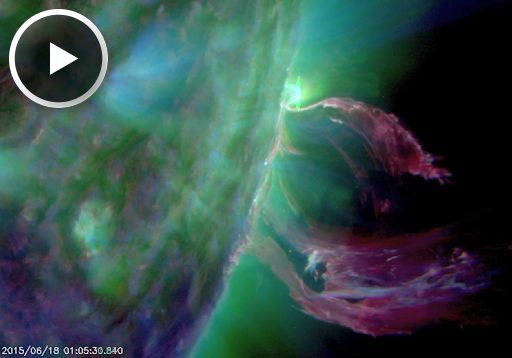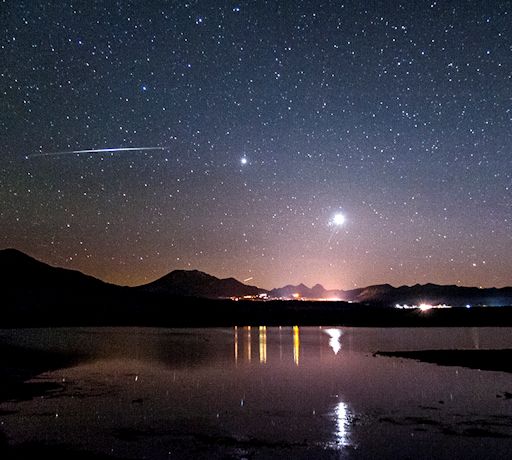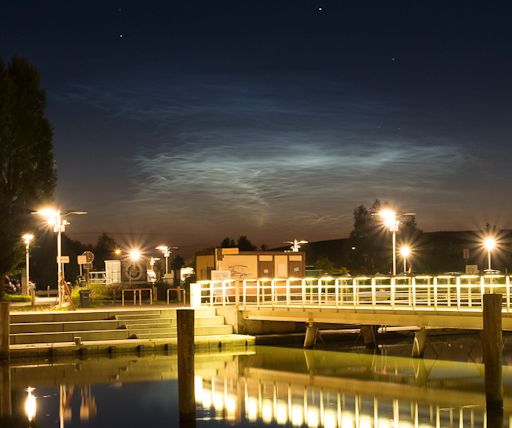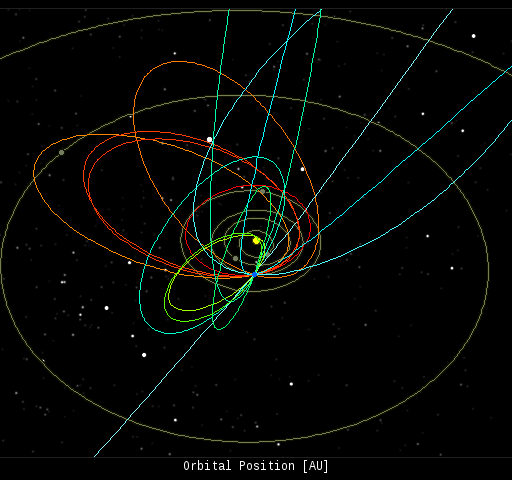Come to Tromsø and share Marianne's passion for rural photography: Chasethelighttours.co.uk invites you to experience "Heaven on Earth" with an aurora, fjord, fishing, whale watching, photography or sightseeing tour. | | |
INCREASING SOLAR ACTIVITY: On June 18th at 1736 UT, Earth-orbiting satellites detected an M3-class solar flare--the strongest flare in nearly 2 months. The source appears to be sunspot AR2371, which has been growing rapidly during the past 24 hours. A CME is emerging from the blast site. It is too soon, however, to say whether or not it is heading for Earth. Stay tuned for updates. Solar flare alerts: text, voice
SPECTACULAR EXPLOSION MISSES EARTH: Departing sunspot AR2365 erupted on June 18th at 0130UT, producing a spectacular prominence on the sun's western limb. NASA's Solar Dynamics Observatory recorded the blast:

Debris from the explosion flew away from the sun in the form of a massive CME. The storm cloud is moving well off the sun-Earth line, however, and is not expected to hit our planet.
The next explosion might not miss. Two big sunspots are facing Earth: AR2371 and AR2367 are growing rapidly with unstable 'beta-gamma' magnetic fields that harbor energy for strong flares. NOAA forecasters estimate a 30% chance of M-class solar flares and a 5% chance of X-flares on June 18th. Solar flare alerts: text, voice
SUNSET SKY SHOW: Readers, if you have not been paying attention to the early evening sky, please start. The two brightest planets, Venus and Jupiter, are converging in the west for a spectacular side-by-side conjunction. Photographer Cat Connor sends this picture from Mammoth Lakes, California:

"The sight of Venus and Jupiter reflecting in a pond and setting over the Sierra Nevada mountain town of Mammoth Lakes was simply breathtaking," says Conner. "To take the picture I used a Nikon D700 digital camera. A 20s exposure at ISO 6400 revealed not only the bright planets, but also the starry background."
Photographers, take note of those settings, because the sunset sky show is going to continue for the rest of the month. Dates of special interest: On June 18th Venus and Jupiter will be only 6 degrees apart, so close together that they could fit inside the bowl of the Big Dipper. On June 19th, the crescent Moon joins the show, together with Venus and Jupiter forming a bright isosceles triangle in the sunset sky. One night later, on June 20th, the vertices rearrange themselves, forming yet another isosceles triangle. Never has a geometry lesson been so beautiful.
The nights of June 19th and 20th are good nights to look through a telescope. Even a small telescope will show you the fat crescent phase of Venus, the cloudtops and largest moons of Jupiter, and the rugged terrain of Earth's own Moon. Swing your optics around the triangle for a fast-paced heavenly show.
The main event occurs on June 30th. On that night, Venus and Jupiter will be a jaw-dropping 1/3rd of a degree apart--less than the diameter of a full Moon. You'll be able to hide the pair behind your little pinky finger outstretched at arm's length. Mark your calendar and enjoy the show!
Realtime Space Weather Photo Gallery
NOCTILUCENT CLOUDS VS. STREET LIGHTS: On June 17th, a bright display of noctilucent clouds (NLCs) appeared in the night sky over Germany. "I saw the noctilucent clouds in the car while driving through the town of Greifswald around midnight," reports Markus Blaurock. "They were easily visible despite street lights."

Blaurock's photo, above, shows that noctilucent clouds can be seen even in light polluted cities. This means that everyone should be alert for them.
Noctilucent clouds first appeared in the 19th century after the eruption of super-volcano Krakatoa. At the time, people thought NLCs were caused by the eruption, but long after Krakatoa's ash settled, the clouds remained. In recent years, NLCs have intensified and spread with sightings as far south as Utah and Colorado. This could be a sign of increasing greenhouse gases in Earth's atmosphere.
Observing tips: Look west 30 to 60 minutes after sunset when the Sun has dipped 6o to 16o below the horizon. If you see luminous blue-white tendrils spreading across the sky, you may have spotted a noctilucent cloud.
Realtime NLC Photo Gallery
Realtime Aurora Photo Gallery
Realtime Sprite Photo Gallery
Every night, a network of NASA all-sky cameras scans the skies above the United States for meteoritic fireballs. Automated software maintained by NASA's Meteoroid Environment Office calculates their orbits, velocity, penetration depth in Earth's atmosphere and many other characteristics. Daily results are presented here on Spaceweather.com.
On Jun. 18, 2015, the network reported 101 fireballs.
(99 sporadics, 1 , 1 Northern June Aquilid)

In this diagram of the inner solar system, all of the fireball orbits intersect at a single point--Earth. The orbits are color-coded by velocity, from slow (red) to fast (blue). [Larger image] [movies]
Potentially Hazardous Asteroids (
PHAs) are space rocks larger than approximately 100m that can come closer to Earth than 0.05 AU. None of the known PHAs is on a collision course with our planet, although astronomers are finding
new ones all the time.
On June 18, 2015 there were potentially hazardous asteroids.
Notes: LD means "Lunar Distance." 1 LD = 384,401 km, the distance between Earth and the Moon. 1 LD also equals 0.00256 AU. MAG is the visual magnitude of the asteroid on the date of closest approach. | | The official U.S. government space weather bureau |
| | The first place to look for information about sundogs, pillars, rainbows and related phenomena. |
| | Researchers call it a "Hubble for the sun." SDO is the most advanced solar observatory ever. |
| | 3D views of the sun from NASA's Solar and Terrestrial Relations Observatory |
| | Realtime and archival images of the Sun from SOHO. |
| | from the NOAA Space Environment Center |
| | the underlying science of space weather |
| | Web-based high school science course with free enrollment |

